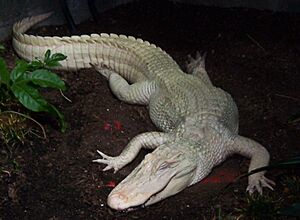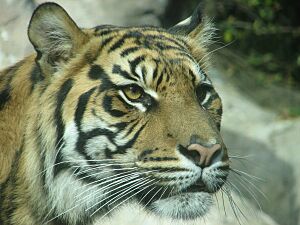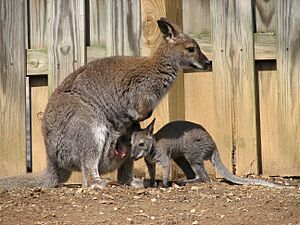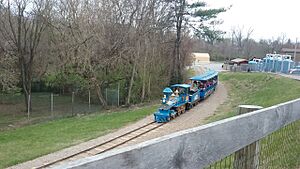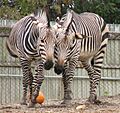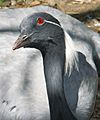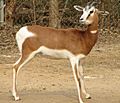Louisville Zoo facts for kids
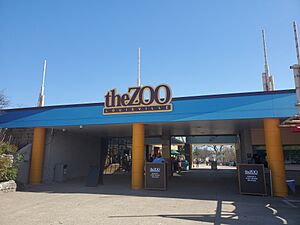
Zoo entrance
|
|
| Date opened | May 1, 1969 |
|---|---|
| Location | Louisville, Kentucky, United States |
| Land area | 134 acres (54 ha) |
| Coordinates | 38°12′19″N 85°42′19″W / 38.20528°N 85.70528°W |
| No. of animals | 1,700 |
| Annual visitors | 900,000+ |
| Memberships | Association of Zoos and Aquariums, American Alliance of Museums |
| Major exhibits | The Islands, Africa, Glacier Run, Australia, South America, HerpAquarium, Gorilla Forest, Cats of the Americas |
The Louisville Zoo is a fun and educational place in Louisville, Kentucky. It covers 134 acres and is home to over 1,200 animals. The zoo opened in 1969 and is known as the "State Zoo of Kentucky." Here, you can see animals living in natural-looking homes that show their different parts of the world or types of habitats.
The Louisville Zoo is officially recognized by important groups like the Association of Zoos and Aquariums and the American Alliance of Museums. Many people visit the zoo each year, with over 900,000 visitors in recent times.
Contents
- Discovering the Zoo's History
- Exploring Animal Exhibits
- Gorilla Forest: A Close Look at Gorillas
- HerpAquarium: Reptiles, Amphibians, and Fish
- Islands: Endangered Species and Unique Habitats
- Wallaroo Walkabout: Get Close to Australian Animals
- Glacier Run: Arctic and North American Animals
- Africa: A Journey to the Serengeti
- Cats of the Americas: Rescued Wild Cats
- South America: From Andes to Amazon
- Kentucky Trails: Native North American Animals
- Special Animal Residents
- Fun Events at the Zoo
- Zoo Incidents and Safety
- See also
- Images for kids
Discovering the Zoo's History
The Louisville Zoo first opened its doors on May 1, 1969. Back then, it had about 250 animals for everyone to see. The land for the zoo was bought by the City of Louisville in the 1960s. A kind person named James Graham Brown gave a lot of money to help build the zoo.
When the zoo first opened, it had many four-legged animals like elephants and giraffes. There was also a train ride that took visitors around the exhibits. This train ran until 2019. At first, some visitors thought the zoo needed more shade, but over time, trees grew and helped with this.
In 1997, a beautiful, old-fashioned carousel was added for visitors to enjoy. Later, in May 2007, the Glacier Run Splash Park opened. This was a water playground for kids with many fun water sprays. The splash park was the first part of the Glacier Run area to open. This area features exhibits for polar bears that look like a town in Canada. The Splash Park closed for a short time in 2022 for repairs and reopened in April 2023.
Exploring Animal Exhibits
The Louisville Zoo has eight main exhibit areas. These include The Islands, Africa, Glacier Run, Australia, South America, HerpAquarium, Gorilla Forest, and the Cats of the Americas. Each area lets you explore different animals and their homes.
Gorilla Forest: A Close Look at Gorillas
The zoo received an award in 2003 for its amazing 4-acre "Gorilla Forest" exhibit. This area is home to a group of eight western lowland gorillas. You can also see a pygmy hippopotamus here. Inside the Gorilla Sanctuary, you can get very close to the gorillas, with only glass separating you.
There are several outdoor spots where you can watch the gorillas play and relax. In October 2022, a female gorilla named Helen passed away. She was one of the oldest gorillas ever, born in 1958.
HerpAquarium: Reptiles, Amphibians, and Fish
The HerpAquarium is home to over 100 different kinds of reptiles, amphibians, and fish from all over the world. You can see animals like boa constrictors, Gila monsters, panther chameleons, and black piranhas.
One special resident is a 9.5-foot-long rare male albino American alligator named King Louie. He is named after a French king, just like the city of Louisville. Louie was born at the St. Augustine Alligator Farm.
The Louisville Zoo also helps protect critically endangered Panamanian golden frogs. The zoo is working to save these frogs from disappearing, as their numbers have dropped due to a fungus and habitat destruction. In 2006, the zoo added a group of common vampire bats. Their exhibit looks like an old mine shaft.
Islands: Endangered Species and Unique Habitats
The "Islands" exhibit is special because it changes the animals on display each day. This allows the animals to explore different parts of their habitat, just like they would in the wild. This keeps them active and aware. This exhibit also features both predator and prey animals in the same space.
All the animals in this exhibit are either endangered or threatened. You might see Sumatran tigers, orangutans, siamangs, North Sulawesi babirusas, Malayan tapirs, Aldabra giant tortoises, and little penguins.
The zoo has three orangutans: a male named Segundo (Gunny) and two females, Amber and Bella. Amber is famous on social media for pointing and asking guests to show her things.
The Islands Pavilion is an indoor area with many bird species. The zoo was the first in the world to hatch the rare white-throated ground-dove in captivity. Other birds here include Victoria crowned pigeons, Nicobar pigeons, and Asian fairy-bluebirds. The pavilion also houses Rodrigues fruit bats, Binturongs, Cuban crocodiles, and Komodo dragons.
Wallaroo Walkabout: Get Close to Australian Animals
Opened in 2007, the Wallaroo Walkabout lets you walk right through the exhibit. Here, you can see common wallaroos and red-necked wallabies. You might also spot Australian birds like the emu and laughing kookaburra. You can interact with the wallaroos and wallabies if you stay on the walkway.
After the Wallaroo Walkabout, you can visit Lorikeet Landing. This is a walkthrough aviary filled with many brightly colored lorikeets. The zoo has 56 lorikeets of five different species. You can even feed nectar to these birds right from your hand! The Wallaroo Walkabout area is being updated by 2025 to include Red kangaroos and Southern cassowarys.
Glacier Run: Arctic and North American Animals
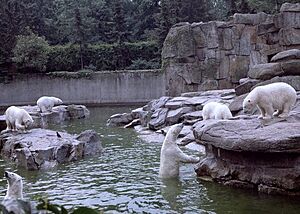
Finished in early 2011, Glacier Run is a 4.3-acre outdoor exhibit. It looks like an old gold-mining town next to a glacier. This area is home to polar bears, harbor seals, gray seals, California sea lions, grizzly bears, snowy owls, and Steller's sea eagles. Outside the town, you can find exhibits for snow leopards and Amur tigers. The children's splash park, which opened in 2007, was the first part of this exhibit to open.
Glacier Run also has classrooms, party rooms, and places to watch animals both above and below water. There's also an outdoor area for watching animal training. A large aviary for Steller's sea eagle Pytr is 50 feet tall. This aviary also houses Azure-winged magpies, baer's pochards, and red-breasted gooses. In 2025, the zoo welcomed two koalas from the San Diego Zoo.
Africa: A Journey to the Serengeti
This part of the zoo is designed to look like the African Serengeti. Here, you can see lions, dromedary camels, southern white rhinoceroses, common warthogs, addaxes, meerkats, and naked mole-rats. Other animals include Hartmann's mountain zebras, Masai giraffes, Rüppell's griffon vultures, and gray crowned cranes. There's also a petting yard with Nigerian Dwarf goats.
Until 2025, the Louisville Zoo was one of the few zoos that had both African and Asian elephants in the same habitat. They were moved to The Elephant Sanctuary in Tennessee. In 2022, the giraffe yard was updated. It is now home to multiple birds alongside the giraffes, like white storks.
Cats of the Americas: Rescued Wild Cats
This exhibit is next to the South America area. It features rescued animals that cannot go back to the wild. You can see Canada lynxes, bald eagles, and pumas here.
South America: From Andes to Amazon
This exhibit showcases animals from the Andes grasslands and Amazon rainforest of South America. It also has a beautiful botanical garden. Animals you can find here include Chilean flamingos, maned wolves, Linnaeus's two-toed sloths, red-crowned cranes, red pandas, and toco toucans. In 2023, a renovated aviary for hyacinth macaws reopened. Also in 2023, 46 new Chilean Flamingos joined the flock, making it one of the largest groups in captivity.
Kentucky Trails: Native North American Animals
A new area called Kentucky Trails is being built, covering about 20 acres. This area will be dedicated to animals from North America. It is being created with Kentucky Fish and Wildlife to house native animals from the Appalachian and Cumberland Gap regions. It will have large areas for American bison, elk, American black bears, bobcats, and other native animals. A large education center and restaurant will also be built. Construction started in 2023, and the exhibit is expected to open in 2025.
Special Animal Residents
- Mojo, a patas monkey, came to the zoo in 2007. He was previously a pet but became too wild to keep at home.
- Scotty, an African elephant, was the first elephant born in Kentucky in 2007. Sadly, he passed away in 2010 due to health issues.
- The Louisville Zoo has hand-raised three baby siamangs: Sungai, Zoli, and Zain. This is very rare, and the zoo is thought to be the only one to have hand-raised three siamangs so young.
- The zoo is also home to several black-footed ferrets and helps with a special program to breed them. These ferrets are one of the most endangered species in North America.
- Bakari, a Masai giraffe, was born in 2009 with a leg problem. He had a special surgery that helped him, and he is believed to be the first giraffe to have this procedure.
- In 2011, a polar bear cub named Qannik was found alone in Alaska. The Alaska Zoo helped rescue her. The Louisville Zoo's new Glacier Run exhibit was a perfect home for her. With help from UPS, Qannik was flown to the zoo in what was called "Operation Snowflake."
- In 2013, the zoo held a contest to name the first zebra foal born at the zoo in 13 years. The foal was named Ziva.
- In 2014, the zoo announced that their 11-year-old reticulated python, Thelma, had six healthy baby snakes in 2012 without a male. This is a rare event called parthenogenesis, where an animal can reproduce without a partner. Genetic tests showed she was the only parent.
Fun Events at the Zoo
The Louisville Zoo hosts many exciting events after its regular hours. One very popular event is the "World's Largest Halloween Party," held every October 31st. Another favorite is "Brew at the Zoo," which brings together local restaurants and craft beer. This event usually happens in August and often sells out. The zoo also has a "Handimals" booth where kids can make animal pictures using their handprints. When a new animal is born at the zoo, they often hold a contest to let people suggest names.
Zoo Incidents and Safety
The zoo takes safety seriously. In 1994, there was an incident where an African elephant picked up a man. The man was injured, but zoo officials said the elephant was usually calm.
In 2009, the zoo train went off its tracks, causing some injuries. The train was closed for four years while the zoo bought new trains and improved safety training. The train reopened in 2013. The old trains were later sold in 2021. In 2019, a sinkhole appeared in an undeveloped area of the zoo property.
See also
- List of attractions and events in the Louisville metropolitan area
- List of parks in the Louisville metropolitan area
- Senning's Park, Louisville's first zoo
Images for kids


